How to Calculate Taxes Owed on Side Hustles, Freelance Work and Gig Income

Having a side hustle or working freelance gigs can be a great way to earn extra income. However, it can also create some confusion when it comes to tax time. Calculating the taxes owed on your gig income is essential for staying compliant with the Internal Revenue Service (IRS) and avoiding any penalties. This article will provide a step-by-step guide on how to calculate your taxes for your side hustles, freelance work, and gig income.
1. Understand your tax bracket and filing status: Your tax bracket depends on your total taxable income, which includes your primary job, side hustles, and any freelance or gig work. Your filing status (single, married filing jointly, etc.) will also affect the tax rate you pay. To find your correct tax bracket and rate, consult the IRS’s tax tables.
2. Determine if you are classified as self-employed: If you earn more than $400 from your side hustle or freelance work in one year, you are considered self-employed by the IRS. This classification means you must pay self-employment tax (Social Security and Medicare taxes) in addition to regular income tax.
3. Keep track of all income and expenses: You will need to report all earnings from your side hustle or freelance work as gross income on your tax return. Keeping track of invoices and payments received is essential for determining this figure accurately. You should also track any business-related expenses since these can help lower your taxable income.
4. Calculate self-employment tax: Self-employment tax comprises Social Security and Medicare taxes paid by self-employed individuals at a combined rate of 15.3%. You can use Schedule SE (Form 1040) to compute these additional taxes.
5. Deduct expenses: As a freelancer or side hustler, you may qualify to deduct certain expenses on your tax return that can lower your taxable income. Common deductions include home office expenses, business-related travel, advertising, and office supplies. To claim these deductions, use Schedule C (Form 1040).
6. Estimate your total taxable income: Add together your primary job income and net income from your side hustles, freelance work, and gig income (the gross income minus any deductions). This sum will determine your total taxable income.
7. Apply the appropriate tax rate: Lastly, apply the tax rate for your filing status and tax bracket to your total taxable income calculated in step 6. This will give you an estimate of the taxes owed on your side hustle and freelance work.
8. Make estimated tax payments (if necessary): If you expect to owe more than $1,000 intaxes from your self-employment earnings, the IRS requires that you make quarterly estimated tax payments throughout the year using Form 1040-ES.
Calculating taxes owed on side hustles, freelance work, and gig income can seem intimidating at first glance. Still, with some understanding of the process and diligent recordkeeping, it becomes much more manageable. Feel confident in knowing that you are correctly accounting for additional earnings to avoid any issues with the IRS come tax time.






